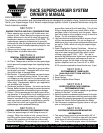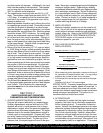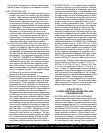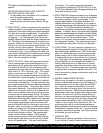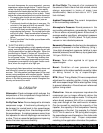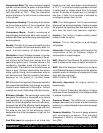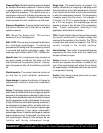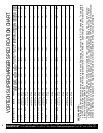
4
© 2000 Vortech Engineering, Inc. All Rights Reserved. International Copyrights Secured. 25FEB00 V 2.0 DRAFT P/N: 008515
Questions?
Please contact: Vortech Engineering, Inc. • 1650 Pacific Ave., Channel Islands, CA 93033-9901
Phone: (805) 247-0226 • Fax: (805) 247-0669 • Website: vortechsuperchargers.com • Hours: M-F 8AM - 4:30PM (PST)
The above mentioned parts are strictly Ford
specific.
APPROVED MOUNTING PLATE SUPPORT
METHODS ARE AS FOLLOWS:
• An adjustable strut rod between the crankshaft
and the supercharger pulley.
• A static strut rod between the supercharger
mounting plate and the engine (header, flange,
etc.).
2. DRIVE BELTS - Vortech recommends the use of the
widest cog belt that is practical and one that is Kevlar
reinforced, to be used to help prevent belt breakage.
The belt must not be overtightened. A cog belt by
design is a non-slipping belt. It only needs to be
snugged up. It is recommended that the belt be
properly tightened only after the engine has warmed
up. This is due to thermal expansion of related com-
ponents. When the vehicle is running, the belt may
look as if it is loose and requires more tension. Do
not buy into this misconception. The belt will not
come off provided that the supercharger bracketry
is sufficiently rigid. If you overtighten the belt, you
may cause crankshaft and/or supercharger bearing
failure which will also cause a premature drive belt
failure. Do not overtighten the belt!
3. DRIVE PULLEYS - When utilizing other manufac-
turer's supercharger and crankshaft pulleys, it is
imperative that the pulleys be matched correctly.
The profile of the teeth on the crankshaft pulley,
supercharger pulley and the drive belt must match
each other (i.e. HTD, Polychain, etc.). The overall
pulley runout must not exceed .010". It is critical
that the pilot on the harmonic balancer fit snugly into
the inside of the crankshaft pulley. Runout must also
be checked once the crankshaft pulley is installed
onto the harmonic balancer. This can easily be done
by turning the engine by hand and utilizing a magnetic
base with a dial indicator. The pulleys also need to
be properly balanced. If the pulleys suffer from ex-
cessive run-out and/or from an out of balance con-
dition, severe vibrations will occur and may cause
an engine and/or supercharger failure. All Vortech
pulleys are rigorously inspected in our Quality Control
Department and will provide "vibration-free" operation
when properly installed. It is always better to start
with a larger supercharger pulley and lower shift
points to help with dialing in the engine and the sus-
pension. Later, you can put on smaller supercharger
pulleys and raise your shift points as your problems
are resolved. Only the crankshaft and idler pulley
should have flanges on them. The supercharger
pulley should not have flanges. Pulley flanges
cause excessive load on the input shaft bearings
by pulling the input shaft in and out during accele-
ration and deceleration. This may cause prema-
ture failure. The supercharger drive assembly
(Ford specific) component (P/N 4FP116-011) of the
V-3/V-4 Race Bracket Pulley Package addresses this
issue with excellent results.
4. AIR FILTRATION - Always use some sort of air filtration
device on the supercharger air inlet to prevent debris
from being ingested into the supercharger. If the
supercharger impeller is damaged by debris, the
impeller will become out of balance. If you continue
to use the supercharger with the impeller out of balance,
it may fail. The air filter should be checked every
maintenance schedule (cleaned and/or replaced, as
needed). In addition, there is a Vortech factory-applied
black index mark between the impeller and the impeller
shaft/nut. If the impeller has moved in relation to the
impeller shaft/nut, this line will be broken. If this
occurs, it is very likely that the impeller has touched
the compressor housing. The supercharger should
immediately be returned to Vortech for inspection.
5. ICING DOWN - It is very important to observe the
following guidelines regarding "icing down" the engine
and supercharger between runs. Wait 20 minutes
after a run before placing ice on the supercharger.
Always remove the ice 30 minutes before the run.
It is preferable to use a large electric fan instead of
ice. "Icing down" the supercharger, especially outside
of these guidelines, can decrease the impeller to
housing clearance due to a differential in thermal
expansion and allow contact that may lead to total
failure of the unit. The supercharger was designed
to operate with a minimum impeller clearance. The
use of ice was not a design consideration and is not
recommended.
6. ENGINE TUNING/FREE REVVING
When tuning the engine in the pits or garage area
using the transmission brake to load the engine, it is
recommended not to rev the engine beyond 6000
rpm. When the engine is decelerated, you must
slowly decrease the engine rpm's over a period of
three to four seconds. Rapid engine/supercharger
deceleration may cause engine and/or supercharger
failures. Any free revving of the engine without a
load on it can cause premature supercharger failure.
Do not free-rev the engine with the supercharger belt
in place while attempting to dial in fuel pressure,
"clean out" the engine on the starting line, etc. We
recommend the use of a hand vacuum/pressure
pump (available at most auto parts stores) for checking
fuel pressures, bypass valves, etc. If you are unable
to locate a source for the pump, call Vortech and we
will provide you with a source.
7. BURNOUT BOX
Extreme care must be exercised in the burnout box.
If your vehicle is traction limited (because you have



